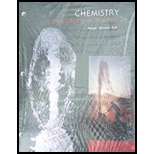
Chemistry Principles And Practice
3rd Edition
ISBN: 9781305295803
Author: David Reger; Scott Ball; Daniel Goode
Publisher: Cengage Learning
expand_more
expand_more
format_list_bulleted
Question
Chapter 13, Problem 13.63QE
Interpretation Introduction
Interpretation:
The factor does the
Expert Solution & Answer
Trending nowThis is a popular solution!

Students have asked these similar questions
First image: Why can't the molecule C be formed in those conditions
Second image: Synthesis for lactone C
its not an exam
First image: I have to show the mecanism for the reaction on the left, where the alcohol A is added fast in one portion
Second image: I have to show the mecanism of the reaction at the bottom. Also I have to show by mecanism why the reaction wouldn't work if the alcohol was primary
First image: I have to explain why the molecule C is never formed in those conditions.
Second image: I have to propose a synthesis for the lactone A
Chapter 13 Solutions
Chemistry Principles And Practice
Ch. 13 - Prob. 13.1QECh. 13 - Prob. 13.2QECh. 13 - What is the difference between the integrated and...Ch. 13 - Prob. 13.4QECh. 13 - Explain why half-lives are not normally used to...Ch. 13 - Derive an expression for the half-life of a...Ch. 13 - Prob. 13.7QECh. 13 - Prob. 13.8QECh. 13 - Prob. 13.9QECh. 13 - Prob. 13.10QE
Ch. 13 - Prob. 13.11QECh. 13 - Prob. 13.12QECh. 13 - Prob. 13.13QECh. 13 - Prob. 13.14QECh. 13 - Prob. 13.15QECh. 13 - Prob. 13.16QECh. 13 - Prob. 13.17QECh. 13 - Prob. 13.18QECh. 13 - Prob. 13.19QECh. 13 - Prob. 13.20QECh. 13 - Prob. 13.21QECh. 13 - Prob. 13.22QECh. 13 - Nitrogen monoxide reacts with chlorine to form...Ch. 13 - Prob. 13.24QECh. 13 - Prob. 13.25QECh. 13 - Prob. 13.26QECh. 13 - Prob. 13.27QECh. 13 - Prob. 13.28QECh. 13 - Prob. 13.29QECh. 13 - Prob. 13.30QECh. 13 - Prob. 13.31QECh. 13 - Prob. 13.32QECh. 13 - Prob. 13.33QECh. 13 - Write a rate law for NO3(g) + O2(g) NO2(g) +...Ch. 13 - Prob. 13.35QECh. 13 - Prob. 13.36QECh. 13 - Prob. 13.37QECh. 13 - Rate data were obtained at 25 C for the following...Ch. 13 - Prob. 13.39QECh. 13 - Prob. 13.40QECh. 13 - Prob. 13.41QECh. 13 - Prob. 13.42QECh. 13 - Prob. 13.43QECh. 13 - Prob. 13.44QECh. 13 - Prob. 13.45QECh. 13 - Prob. 13.46QECh. 13 - Prob. 13.47QECh. 13 - Prob. 13.48QECh. 13 - When formic acid is heated, it decomposes to...Ch. 13 - Prob. 13.50QECh. 13 - The half-life of tritium, 3H, is 12.26 years....Ch. 13 - Prob. 13.52QECh. 13 - Prob. 13.53QECh. 13 - Prob. 13.54QECh. 13 - Prob. 13.55QECh. 13 - Prob. 13.56QECh. 13 - The decomposition of ozone is a second-order...Ch. 13 - Prob. 13.58QECh. 13 - Prob. 13.59QECh. 13 - Prob. 13.60QECh. 13 - A reaction rate doubles when the temperature...Ch. 13 - Prob. 13.62QECh. 13 - Prob. 13.63QECh. 13 - Prob. 13.64QECh. 13 - Prob. 13.65QECh. 13 - The activation energy for the decomposition of...Ch. 13 - Prob. 13.67QECh. 13 - Prob. 13.68QECh. 13 - Prob. 13.69QECh. 13 - Prob. 13.70QECh. 13 - Prob. 13.71QECh. 13 - Prob. 13.72QECh. 13 - Prob. 13.73QECh. 13 - Prob. 13.74QECh. 13 - Prob. 13.75QECh. 13 - Prob. 13.76QECh. 13 - Prob. 13.77QECh. 13 - Prob. 13.78QECh. 13 - Prob. 13.79QECh. 13 - Prob. 13.80QECh. 13 - The gas-phase reaction of nitrogen monoxide with...Ch. 13 - Prob. 13.82QECh. 13 - Prob. 13.83QECh. 13 - A catalyst reduces the activation energy of a...Ch. 13 - Prob. 13.85QECh. 13 - Prob. 13.86QECh. 13 - Prob. 13.87QECh. 13 - Prob. 13.88QECh. 13 - Prob. 13.89QECh. 13 - Prob. 13.90QECh. 13 - Prob. 13.91QECh. 13 - Prob. 13.92QECh. 13 - Prob. 13.93QECh. 13 - Prob. 13.94QECh. 13 - Prob. 13.95QECh. 13 - Prob. 13.96QECh. 13 - Prob. 13.98QECh. 13 - Prob. 13.99QE
Knowledge Booster
Similar questions
- 20.44 The Diels-Alder reaction is not limited to making six-membered rings with only car- bon atoms. Predict the products of the following reactions that produce rings with atoms other than carbon in them. OCCH OCCH H (b) CH C(CH₂)s COOCH མ་ནས་བ (c) N=C H -0.X- (e) H C=N COOCHS + CH2=CHCH₂ →→arrow_forwardGiven the attached data, provide the drawing for the corresponding structure.arrow_forwardno Ai walkthroughsarrow_forward
arrow_back_ios
SEE MORE QUESTIONS
arrow_forward_ios
Recommended textbooks for you
 Chemistry: Principles and PracticeChemistryISBN:9780534420123Author:Daniel L. Reger, Scott R. Goode, David W. Ball, Edward MercerPublisher:Cengage Learning
Chemistry: Principles and PracticeChemistryISBN:9780534420123Author:Daniel L. Reger, Scott R. Goode, David W. Ball, Edward MercerPublisher:Cengage Learning Chemistry: The Molecular ScienceChemistryISBN:9781285199047Author:John W. Moore, Conrad L. StanitskiPublisher:Cengage LearningChemistry: Matter and ChangeChemistryISBN:9780078746376Author:Dinah Zike, Laurel Dingrando, Nicholas Hainen, Cheryl WistromPublisher:Glencoe/McGraw-Hill School Pub Co
Chemistry: The Molecular ScienceChemistryISBN:9781285199047Author:John W. Moore, Conrad L. StanitskiPublisher:Cengage LearningChemistry: Matter and ChangeChemistryISBN:9780078746376Author:Dinah Zike, Laurel Dingrando, Nicholas Hainen, Cheryl WistromPublisher:Glencoe/McGraw-Hill School Pub Co Chemistry by OpenStax (2015-05-04)ChemistryISBN:9781938168390Author:Klaus Theopold, Richard H Langley, Paul Flowers, William R. Robinson, Mark BlaserPublisher:OpenStax
Chemistry by OpenStax (2015-05-04)ChemistryISBN:9781938168390Author:Klaus Theopold, Richard H Langley, Paul Flowers, William R. Robinson, Mark BlaserPublisher:OpenStax Chemistry: An Atoms First ApproachChemistryISBN:9781305079243Author:Steven S. Zumdahl, Susan A. ZumdahlPublisher:Cengage Learning
Chemistry: An Atoms First ApproachChemistryISBN:9781305079243Author:Steven S. Zumdahl, Susan A. ZumdahlPublisher:Cengage Learning Chemistry & Chemical ReactivityChemistryISBN:9781337399074Author:John C. Kotz, Paul M. Treichel, John Townsend, David TreichelPublisher:Cengage Learning
Chemistry & Chemical ReactivityChemistryISBN:9781337399074Author:John C. Kotz, Paul M. Treichel, John Townsend, David TreichelPublisher:Cengage Learning

Chemistry: Principles and Practice
Chemistry
ISBN:9780534420123
Author:Daniel L. Reger, Scott R. Goode, David W. Ball, Edward Mercer
Publisher:Cengage Learning

Chemistry: The Molecular Science
Chemistry
ISBN:9781285199047
Author:John W. Moore, Conrad L. Stanitski
Publisher:Cengage Learning

Chemistry: Matter and Change
Chemistry
ISBN:9780078746376
Author:Dinah Zike, Laurel Dingrando, Nicholas Hainen, Cheryl Wistrom
Publisher:Glencoe/McGraw-Hill School Pub Co

Chemistry by OpenStax (2015-05-04)
Chemistry
ISBN:9781938168390
Author:Klaus Theopold, Richard H Langley, Paul Flowers, William R. Robinson, Mark Blaser
Publisher:OpenStax

Chemistry: An Atoms First Approach
Chemistry
ISBN:9781305079243
Author:Steven S. Zumdahl, Susan A. Zumdahl
Publisher:Cengage Learning

Chemistry & Chemical Reactivity
Chemistry
ISBN:9781337399074
Author:John C. Kotz, Paul M. Treichel, John Townsend, David Treichel
Publisher:Cengage Learning